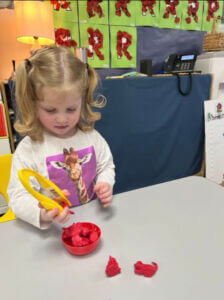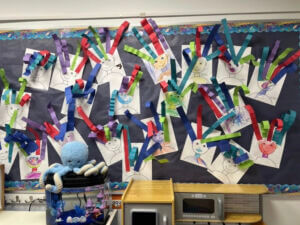Stamping to Tapping Feet: How the Geneva Method Invites Two-Year-Olds to Step Up
Terrible twos?
Terrific twos!
The tiniest of scholars may have a reputation for tantrums, yet the professionals at Geneva Day School (GDS) see promise in stamping feet.
“Starting preschool is a big developmental milestone for a toddler,” acknowledges Mrs. Porras, a passionate GDS Teacher of Twos. As these students experience ”their first separation from home,” they achieve - also for a first time - “social skills and confidence,” she explains.
Soon, frequent embraces designed to reassure the newly arrived give way to interactions of exploration and inquiry.
“Would you like to buckle your shoe?”
“What might you say to your friend?”
“How many balls do we count?”

Geneva Method from the Children’s Perspective
These questions can only be answered by the young scholars who are honored for their emerging sense of self. “Meeting children at their level” is how Director Lizama describes the Geneva Method which “fosters the desire to explore,” an approach she has enacted throughout her nearly two decade tenure as a teacher within the school and that she continues to impart today from the helm.
In so doing, the school revels in a warm and nurturing environment where “learning occurs through play” says Mrs. Porras. Her own early childhood insights are deepened through having taught
Kindergarten at the school. Well-versed in the Geneva Method, she guides pre-academic learning by placing student-interests first.
Two-year-olds learn “seasons, dressing for the weather, days of the week, and holiday celebrations” explains Mrs. Porras. Attuned to student fondness for dinosaurs, under-the-sea creatures, and
transportation, she introduces new subjects through thematically meaningful props.
Of equal importance are “the students’ fine motor skills (which) develop through activities like creating crafts with crumpled tissue paper, mosaics of construction paper, lacing wooden figures, and ripping paper,” says Mrs. Porras. Irresistible materials, presented within the context of a story or theme, serve as exciting introduction to paints, paper, crayons, and eventually scissors.
“All this is quite a work-out for those little hands!” she exclaims.

Geneva Method from the Teachers' Perspective
Like all GDS teachers, Mrs. Porras’s ensures that student output is honored through ever-evolving bulletin boards. Collaged butterflies (what symmetry!) and hand-cut snowflakes (what pattern!)
glimmer above the Lilliputian landscape of her classroom.
The Geneva Method encourages staff to act on inspiration; Mrs. Porras feels cheered when engaging her aesthetic sense to shape her domain. Small tables and chairs create the contours of welcome.
Lamps cast soft light. Carpets invite circle-gatherings. Coves of cubbies inspire scholars to “put things away.” Any who spend time within a GDS classroom remark on the gentle profusion of color and a sense of proportion. Such enchantment enfolds the youngest scholars with warmth and inducement to mature.
“The children learn routines and structure like sitting at the table, eating by themselves, and putting on coats,” describes Mrs. Porras. Through routine, comes responsibility. Class plants require tending by student-botanists, just as pets (such as academically-inclined fish; they always travel in schools!) receive daily feedings under teacher-supervision. Scholars feel the call to help, participate, and become custodians of their classroom.
“(These) early childhood experiences are important because they provide the foundation for all future learning, behavior and health,” states Director Lizama. In little time, two-year-old scholars feel
comfortable coming to school and engaging in a GDS day. Such early, positive experience springboards them into academic careers that take place with confidence.

Geneva Method in the Years Beyond
All GDS students profit from the Geneva Method, which is shaped by a spiraling curriculum. Lessons learned one year as a theme or a module are expounded upon in the next, with greater detail and depth.
As Mrs. Porras describes, “A child, through his/her time at Geneva, will be progressively exposed to learning concepts. In the literacy department, starting from letter recognition at three-years-old, to letter formation at four-years-old, to word and sentence formation in K, at five-years-old.”
Likewise, she notes the progressive nature of numbers. “In the math department, starting with rote counting, at two-years-old, as well as counting to one hundred and addition and subtraction concepts, at five-years-old in K,” she states.
In joyful support of the pre-academics that occur in the classroom, are GDS specials, led by accomplished staff and visiting experts. Such specials include Art, Environmental Education, Music,
Physical Education, and Mindfulness. Students delight in this enrichment, often drawing from lessons gleaned at the easel, within an obstacle course, or under the canopy of the Outdoor Classroom, while in pursuit of carpet and table-based learning.
Geneva Method from the Parents’ Perspective
Just as GDS students are embraced by the innovation and warmth of the Geneva Method, so too are their parents. An enthusiastic GPA welcomes families into the fold. Opportunities to support the school recur throughout the year, from the Harvest Festival in the fall to the Auction in the spring. (This year’s theme is the Geneva Derby!)
Teachers invite parents, as the school calendar permits, to read a storybook, guest-lecture about a profession, or to chaperone a field trip. A number of parents are GDS graduates themselves, enrolling their own children so as to grant the gift of a Geneva education. Multi-generational involvement in the school is testament to the success of the Geneva Method and the strength of devotion engendered over decades.
According to GDS parent Mrs. Lisa Sylvester, “I am a working parent. I wish I could be with my child all day long. But I can’t. So I want to know that the people who I am leaving my child with are taking care of my child and loving my child in the way I would if I were at home.”
Such love is tangible in the “Geneva Method (which is) defined by being guided by the child and embracing his/her curiosity. . . We are working not just with the child, but also with the family,” states Director Lizama about the school’s compassionate, expansive approach.
Geneva Day School as “Best Preschool”
Heartwarmingly, readers of “Bethesda Magazine” and “Potomac Lifestyle” have again recognized GDS as “Best Preschool,” with additional commendation of its Summer Program, Geneva Summer Camp for Young Children. Both the academic year and summer months unfold in GDS’s ideally appointed campus.
Classrooms sprawl as a cozy warren. Wide windows overlook Maryland Green School grounds. A bamboo forest, fairy tale bridge, innovative playground, flower gardens, and Monarch Butterfly
Waystation invite exploration and discovery. Frequent field trips, which could be parent-accompanied, take place to the nearby creek.
“Walking both with the children and walking with parents, this makes them part of the Geneva Family,” Director Lizama attests.
Truly, the stamping feet of incoming two-year-olds become tapping ones when choreographed to pre-academic learning. Although there is no martinet to ensure a particular pace or rhythm, therein lies the radiance of the school’s approach. Each child is “met where he or she may be,” states Director Lizama, knowingly. What a thrill to discover where young scholars’ paths will lead once paved by the Geneva Method.
To learn more about Geneva Day School and the Geneva Method, please visit our website. If you are interested in filling out an application for the 2024 - 2025 school year, please click here.
